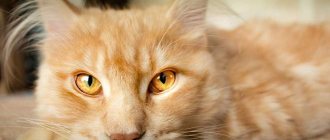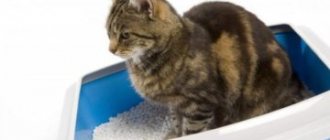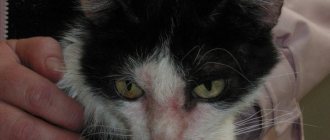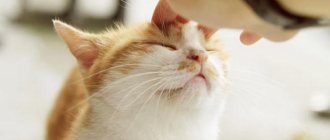A red spot on a cat’s tongue may appear when the defense mechanisms of the immune system are weakened. In veterinary medicine, this unpleasant formation around the mouth, accompanied by an inflammatory reaction, is known as cheilitis. Seizures on the gums or in the oral cavity can cause fungal infections, mechanical damage and other causes. As soon as your cat has growths and wounds on the jaw or in the lip area, you should contact a veterinarian who will tell you what to do, how to cope with the sores or remove the tumor.
Types of diseases: causes and symptoms
Mechanical damage
Sores in the oral cavity in cats are the result of injuries of varying severity. Often, a pet bites the inside of its cheek while eating, as a result of which a wound forms inside the mouth, which can cause inflammation in the cat. Also, sores near the lips are the result of thermal, chemical and electrical burns. Veterinarians warn owners that if a cat burns its mouth outside or inside, they should immediately contact a veterinary clinic, since there is a high probability of damage to internal organs, which can lead to dangerous complications and death of the animal. When a pet is burned, not only soreness and redness are observed, but also other symptoms:
- indecisiveness when trying to eat, and sometimes the pet refuses to eat altogether;
- pain syndrome;
- increased salivation;
- resistance when owners try to look at the mouth;
- inflammation of the mucous membrane, in which there is a high probability of infection.
Pathology caused by a foreign body
When damaged by a third-party object, the animal’s mouth often festers due to an infection.
Cats often like to play with various special toys, and some of them like to chew twigs. If a foreign object enters the oral cavity, the animal's palate, inner cheek, or mucous membrane in the jaw area may be damaged. If you don’t pay attention to the sore in time, it will soon fester, a black coating may appear, and the seals’ mouth may smell unpleasant. Such symptoms signal an inflammatory process and infection in the oral cavity.
Infections and other pathogenic microorganisms that provoke stomatitis
This oral disease in cats is characterized by an inflammatory process in the gum area and at the top of the throat. Veterinarians have not been able to fully understand the reasons for the development of the disease, but the main factor in the appearance of sores is an inadequate reaction to substances with which the upper part of the teeth comes into contact. It is possible to recognize a disease in the mouth area of a cat by the following symptoms:
- meow;
- restless behavior;
- inability to eat;
- unpleasant odor from the mouth;
- whitish or gray coating on the mucous membrane;
- pain that intensifies when the cat opens and closes its mouth;
- swelling of the salivary glands in cats and red tongue;
- weight loss.
How to recognize a fungal infection?
If a cat has a white coating on its tongue, this indicates a fungal infection.
A cat's white tongue and various sores around the mouth are often the result of fungal activity in the cat's body. The main source of the problem is the proliferation of pathogenic microorganisms such as Candida albicans. The main sign of a fungal infection is a whitish coating and light bumps that appear on the mucous membrane of the mouth or near the lips. The following factors can influence the disease:
- other diseases in the cat’s oral cavity;
- long-term use of antibacterial drugs;
- reduced defense mechanisms of the immune system.
If a cat has a sore mouth for a long time and fungal sores are detected, and treatment is not carried out in a timely manner, then there is a high probability of developing pathologies that are dangerous to the health and life of the pet. Oral fungi are especially dangerous for kittens with weak immune systems.
Gum inflammation
Seizures that appear in a cat’s mouth are a signal of the development of an inflammatory reaction. Low quality food can affect the sore, and when a pet’s gums become inflamed, the following symptoms are additionally recorded:
- redness of the mucous membrane;
- edema;
- bleeding gums;
- pain that worsens when eating.
How to recognize an inflammatory process in the tongue?
Sores near the mouth may indicate an inflamed tongue, such a disease is called glossitis. The development of the disease is influenced by infection, mechanical damage, irritation and other unpleasant factors. When inflamed, the root of the tongue turns red and swells, and other alarming symptoms are observed:
- increased salivation;
- refusal to eat;
- strong pain.
Impaired salivation
When a cat develops spots on the tongue and rots in the mouth, this may indicate improper function of the salivary glands. The following factors can influence sores in a cat’s mouth:
- Excessive saliva production. Pain in the oral cavity and pathological growths can occur due to hyperfunction of the salivary glands. The problem may also be the pet's inability to swallow the liquid that appears. A dangerous cause of increased salivation is rabies.
- Salivary gland cyst or mucocele in a cat. A tumor that forms in the mouth is the result of a damaged integrity or the gland itself. The pet is worried about sores in the mouth, fever, difficulty breathing, and pain.
Etiology of the disease
By origin, there are two types of stomatitis: primary and secondary. Primary stomatitis appears due to exposure of the mucous membrane to any factors (high or low temperatures, traumatic substances, etc.).
Secondary develops as a result of some other disease, that is, it is a symptom of it.
The causes of secondary stomatitis may be:
- infections – parvovirus, plague, panleukopenia and others;
- diabetes;
- metabolic disease;
- poor metabolism;
- hormonal diseases;
- fungal infections.
Diagnostic procedures
Having identified pathological changes in the pet’s oral cavity, you should consult a veterinarian for advice.
A seemingly healthy cat may have various sores in the mouth, so owners need to examine it more often to identify the problem early. If the oral mucosa is covered with black, white and other pathological spots, then you should consult a veterinarian. To make a diagnosis, sometimes a specialist only needs a visual examination of the damaged area. If it was not possible to determine the severity and cause of the sore in this way, then additional laboratory and instrumental examinations are carried out.
Routes of infection
Sick cats release the virus into the external environment through discharge from the eyes and nose, and saliva. When you sneeze, the infection spreads through the air several meters around. The virus can easily be brought into the house from the street on clothes, shoes, or hands.
Attention! Domestic cats often become infected through contact with an outdoor kitten brought into the house.
The main routes of infection with calcivirus infection:
- contact with a sick animal;
- airborne;
- through household items - tray, bowls, combs, bedding, cat houses, toys.
Transmission of the pathogen through urine and feces is of less importance. Cats primarily become infected through the mouth or by inhaling viral particles. The virus persists in the environment for about 1–2 weeks, less often up to 1 month. This depends on external conditions - the presence of wet cleaning, indoor air parameters. Humidity and low temperatures increase the viability of the virus. The risk of an infectious outbreak exists in nurseries, with group housing of animals, the appearance of new cats, with poor feeding, and poor indoor air (dusty, dry, hot). Group housing increases the virulence of the virus, and the infection can be more severe.
Necessary treatment
When a cat develops mouth sores, the veterinarian selects individual therapy, depending on the complexity and type of problem. A sick cat is prescribed cleaning of the oral cavity with antiseptics or plant-based decoctions with an astringent effect. If the sore is associated with an infection, then treatment is supplemented with antibacterial drugs. If there are wounds in the pet’s mouth, it hurts to chew and eat, so it’s worth switching it to liquid food or soft food. When the sores completely go away, the animal is given its usual food. If the source of the pathology lies in the destruction of one or more teeth, then their removal is possible. The chronic course of the disease often requires removal of the cat’s entire dentition. To speed up the healing of wounds around the mouth, it is recommended to apply special ointments with a regenerating effect several times a day.
Classification according to the nature of inflammation
According to the degree of inflammation and visual transmission of lesions, the disease occurs in the following forms.
- Gangrenous form.
Gangrenous stomatitis in cats
Tissues in the animal’s mouth die, poisons from the necrotic tissues enter the body, poisoning the internal organs.
The cat refuses food, the bad breath becomes unbearable, the lips and gums become inflamed, the temperature is very high, and the lymph nodes are enlarged.
- Phlegmonous form in cats.
It manifests itself as a change in the color of the mucous membrane, from pink to white, then to bluish. Subsequently, pus forms under the layer.
- Granulation form.
This form manifests itself in the form of ulcers on the cat’s oral mucosa. The ulcers resemble granules filled with pus, which, when damaged, create areas that are easily accessible to infection.
This form is very dangerous, since the lesions can be extensive and reach the skull.
Calcivirosis
Ulcers on the tongue due to calcivirosis.
Unvaccinated kittens older than two months get sick.
The main clinical symptoms are ulcerative stomatitis and conjunctivitis. High infestation and abundance of fleas increase susceptibility to the disease. Most often, kittens become infected in nurseries with crowded housing and unbalanced feeding. Mortality reaches up to 30%.
In the acute course of the disease, in addition to those mentioned, the following symptoms are observed:
- profuse salivation;
- halitosis - stench from the mouth;
- lameness - appears suddenly and disappears after a few days;
- sneezing;
- in severe cases of the disease, pneumonia develops;
- convulsions occur;
- fear, the cat tries to hide, or vice versa, aggression.
Before death, diarrhea and vomiting occur. In adult pets up to two years of age, the disease occurs with signs of mild malaise or asymptomatic.
The cause of the disease is determined by the clinic, anamnesis is collected, a general blood test is performed, and the pathogen is identified by PCR. Treatment is carried out in the clinic.
The following groups of drugs are used:
- antiviral antibodies - hyperimmune gamma globulin Vitafel, used for the first 2 days of treatment;
- immunomodulators: Maxidin; Fosprenil; Feliferon;
- detoxicants: Ringer-Locke solution or analogues;
- mouth sanitation products - Chlorhexidine, Lugol's solution;
- eye drops;
- restoratives - Gamavit, Katozal.
Be sure to read:
Why does a cat lick under its tail until it becomes bald - it can be dangerous!
It is painful for the kitten to chew, so dry food is soaked or wet food is used. Prevention - comfortable keeping, adequate nutrition, immunization of kittens and adult animals before mating, regular extermination of worms and fleas.
Infectious disease mycoplasmosis - symptoms, treatment
If your cat has blackness around his mouth, the cause may also be infectious lesions. One of the most common diseases is mycoplasmosis. The disease is characterized by a number of signs:
- mucous membranes change color and become darker;
- conjunctivitis develops before the eyes (the eyes turn sour);
- purulent fluid with an unpleasant odor is released from the mouth and nasal passages;
- the pet refuses to eat and behaves lethargically.
The infectious disease is especially dangerous for pregnant animals. There is a risk of miscarriage, and even timely treatment is not always effective in saving the offspring. The main reason for infection is a decrease in the body’s defenses against the background of serious diseases. Antibacterial drugs and drugs that enhance immunity are used for treatment.
Fungal infections are one of the causes of blackness in the corners of a pet’s mouth.
Having noticed something black near the mouth of a cat, pet owners should be wary - such a sign may indicate the development of fungal diseases. It is not possible to determine the type of infection on your own; special studies will be required.
Remember! Most often, fungal diseases spread against the background of reduced immunity. This usually occurs in small kittens or in adult animals that have suffered a serious illness.
The danger of the disease is that if left untreated, the disease will progress rapidly. The lesion spreads through the mucous membranes and affects internal organs. Fungal spores can also penetrate the mucous membranes of the eyes and ear canals.
Antifungal drugs or antiseptics are used for treatment. Only a veterinarian prescribes medications, determining after research what exactly to use in an individual case, the dosage, and the duration of the course.











